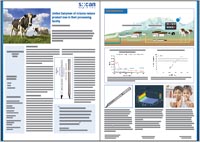s::can’s spectro::lyser monitors the COD in the waste water stream of UDA’s dairy process plant in Tempe, Arizona. This results in lower product loss and decreased wastewater charge by the municipality.
United Dairymen of Arizona reduce product loss in their processing facility

Background
Background
United Dairymen of Arizona is an agricultural milk marketing cooperative incorporated in 1960. UDA’s modern manufacturing facility can process 10 million pounds of milk per day and produces several dairy products like nonfat dry milk, cream, butter, skim milk, condensed skim milk and lactose powder. Product loss represents a large cost for dairy processing plants. During cleaning cycles and maintenance, product is sometimes routed to the drain due to a process change or human intervention. This does not only result in loss of valuable product, but also in COD spikes in the sewage system, which affects the rate a dairy is charged by the municipality. A realtime method of measuring product losses in the effluent can therefore result in a very short return on investment (ROI).
s::can’s solution
To improve product retention and reduce effluent COD it is necessary to understand the contributions of different process streams to the effluent. The s::can spectro::lyser was installed to monitor these various streams in a combined wet well. The spectro::lyser is a submersible UV-Vis spectrophotometer that can convert the raw absorption “fingerprint” of the waste stream into a COD value. The spectro::lyser was combined with s::can’s moni::tool, an advanced event detection system that can alert the user to abnormal changes in the effluent composition. With s::can’s proprietary algorithms the event detection system can be trained to recognize different process streams (i.e. skim milk, whole milk, 2% cream, etc.). By sampling each of the process trains and reviewing the data, UDA and s::can determined the differentiation between the streams based on the UV-Vis fingerprint. This information enabled UDA to determine that there were opportunities in the process for significant improvements, which would ultimately produce a higher quantity of a sellable product rather than sending the product to the Wastewater Treatment Plant. By monitoring these events in the wastewater stream, UDA was able to instantly act on an event alarm and pro actively optimize their procedures resulting in significant cost savings.
